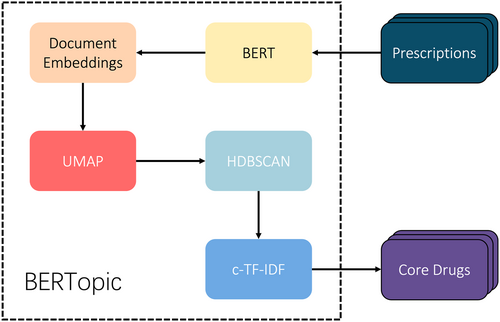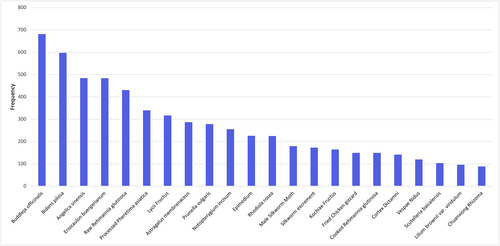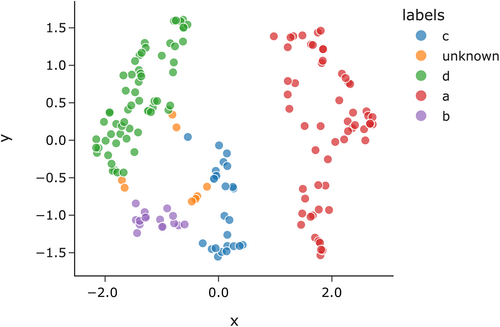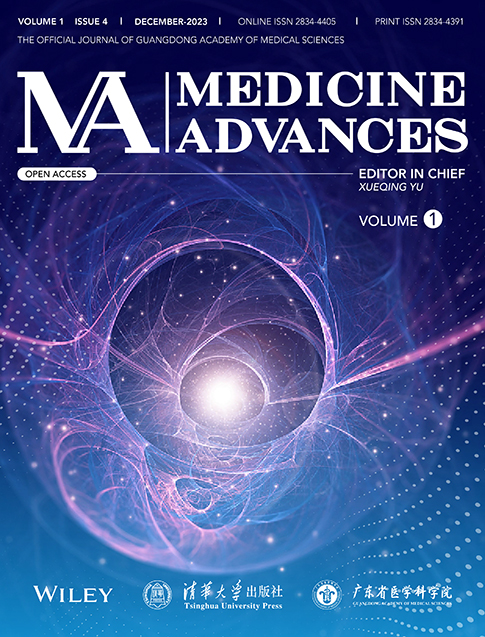Research on a data mining algorithm based on BERTopic for medication rules in Traditional Chinese Medicine prescriptions
Abstract
Background
A data mining algorithm is proposed based on BERTopic to provide new insights into the analysis of medication rules in Traditional Chinese Medicine (TCM) prescriptions.
Methods
Using the BERTopic algorithm, collected TCM prescriptions for corneal diseases are converted to embeddings through a transformer based on the Bidirectional Encoder Representations from Transformers pre-trained model. Then, Uniform Manifold Approximation and Projection is applied to perform dimensionality reduction in prescription embeddings. Subsequently, Hierarchical Density-Based Spatial Clustering of Applications with Noise is used for clustering. Finally, class-based term frequency–inverse document frequency is used to generate several main drug combinations from the clustered results.
Results
The highest frequency of drugs used included Buddleja officinalis, Bidens pilosa, Angelica sinensis, Eriocaulon buergerianum, and Raw Rehmannia glutinosa. The most frequent drug combinations were “Eriocaulon buergerianum, Raw Rehmannia glutinosa, Prunella vulgaris, Notopterygium incisum” “Lycii Fructus, Bidens pilosa, Buddleja officinalis” and “Kochiae Fructus, Cortex Dictamni.”
Conclusions
The proposed data mining algorithm based on BERTopic demonstrated promising outcomes in the analysis of TCM prescription medication rules. This method exhibited simplicity and efficiency, thereby offering a novel avenue for analysis.
Abbreviations
-
- BERT
-
- bidirectional encoder representations from transformers
-
- c-TF-IDF
-
- class-based term frequency–inverse document frequency
-
- DNN
-
- deep neural network
-
- HDBSCAN
-
- hierarchical density-based spatial clustering of applications with noise
-
- NLP
-
- natural language processing
-
- TCM
-
- traditional Chinese medicine
-
- TF-IDF
-
- term frequency–inverse document frequency
-
- UMAP
-
- uniform manifold approximation and projection
1 INTRODUCTION
Data mining is a method that can extract potentially valuable information from a large amount of random and fuzzy data, and is commonly used to analyze the medication rules for Traditional Chinese Medicine (TCM) prescriptions. The mining methods mainly used in the field of TCM include association analysis, clustering analysis, factor analysis, the genetic algorithm, and deep neural networks (DNNs) [1-3]. Bidirectional Encoder Representations from Transformers (BERT) is an advanced deep learning pre-trained language model that has achieved remarkable results in a wide range of natural language processing (NLP) tasks [4]. In this study, a topic modeling algorithm called BERTopic was used to analyze the medication rules in 1276 TCM prescriptions for corneal diseases from the Zhejiang Hospital of TCM from 2016 to 2021.
2 METHODS
Clinical TCM mainly uses TCM prescriptions to treat diseases. Data mining methods can effectively mine prescription data deeply to provide the basis for the analysis of medication rules [5]. The theory of TCM properties contains ambiguity and conceptuality, which makes the research of TCM a great challenge as many words and phrases have been used through extension, metonymy, or other methods, resulting in the phenomenon of polysemy [6]. Conceptual and ambiguous challenges also exist while translating sentence and word meanings with NLP. To enable computers to understand and process natural language, people have trained many excellent models using DNN technology [7].
In this paper, we adopt the BERTopic algorithm to obtain the core prescription through topic extraction and then analyze the correlation between drugs according to the normalized c-TF-IDF score.
2.1 BERTopic
BERTopic is a neural topic model with a class-based (c) Term Frequency–Inverse Document Frequency (TF-IDF) algorithm that mainly uses BERT, Hierarchical Density-Based Spatial Clustering of Applications with Noise (HDBSCAN), Uniform Manifold Approximation and Projection (UMAP), and c-TF-IDF [8]. It can understand the input text using a neural network and extract several topics discussed in the text, each containing several keywords. The technical flow chart is shown in Figure 1.

Technical flow chart of BERTopic. First, prescriptions in the form of documents are embedded by the bidirectional encoder representations from transformers pre-trained model. Then, UMAP is used for dimensionality reduction. Next, embeddings are clustered through HDBSCAN. Finally, core drugs are generated by c-TF-IDF as several topic words from the document.
2.2 Document embeddings
BERTopic assumes that documents that contain the same topic are semantically similar. The documents are embedded through Sentence-BERT (SBERT) [9]. This is a framework that can convert sentences and paragraphs to dense vector representations using the BERT pre-trained model.
In this study, for TCM prescriptions, the Chinese-supported paraphrase-multilingual-MiniLM-L12-v2 pre-trained model is used to perform the embedding step for each prescription, which results in prescription embedding.
2.3 Dimension reduction
The embeddings have hundreds of dimensions, which makes differences in distance measurement unclear. To improve the clustering effect, the dimensionality of embeddings needs to be reduced. BERTopic uses UMAP for dimension reduction to reduce the dimensionality of document embeddings.
UMAP is an advanced dimension reduction algorithm based on the theoretical framework of Riemannian geometry and algebraic topology [10]. It assumes that the data satisfy the following three conditions: (1) data should be uniformly distributed on an existing Riemannian manifold; (2) the underlying manifold of interest is locally connected; and (3) the topology of the manifold is constant.
The algorithm performs excellently and has been shown to retain more global and local features of high-dimensional data in the lower dimension, as in the research sentence vector with hundreds of dimensions are able to reduce to no more than 10 vector groups or even less; hence, it works well with real-world data and has been widely applied in various fields [11]. Through manifold modeling, the equivalent fuzzy topology can be used to obtain the projection of prescription embeddings in lower dimensions.
2.4 Document clustering
The dimensionality reduced embeddings are clustered by HDBSCAN. HDBSCAN is a spatial clustering algorithm based on hierarchical density with noise, which can solve clustering problems with various densities through parameter control [12]. It mainly includes five steps: spatial transform, building the minimum spanning tree, constructing the hierarchical structure of cluster groups, compressing the cluster tree, and extracting clusters.
Compared with traditional clustering algorithms, the HDBSCAN algorithm effectively improves the clustering effect of multiple topics.
2.5 Topic representation
 ()
() ()
() ()
()For TCM prescriptions, the value of TF is the frequency with which a single TCM appears in a series of prescriptions and the value of IDF reflects the frequency with which the TCM appears in the corpus. The product of TF and IDF indicates the importance of the drug for a series of prescriptions.
 ()
()According to the clustering results, c-TF-IDF splices documents in each class and calculates TF-IDF, thereby effectively mining keywords in each topic class.
3 APPLICATION
3.1 Dataset
The prescription data used in this study was sourced from the Department of Ophthalmology at Zhejiang Hospital of TCM, and covered the period from January 2016 to December 2021. After the data were filtered, a total of 1276 valid prescriptions for the treatment of corneal disorders were selected for analysis in this study.
Microsoft Excel was used as the storage format for the data, which recorded the drugs and their dosages in each prescription. Among the 1276 prescriptions used for treating corneal disorders, a total of 127 Chinese herbal medicines were included. Through frequency analysis, it was found that Buddleja officinalis and Bidens pilosa appeared the most frequently in the prescriptions (Figure 2).

Drug frequency distribution. Frequency represents the number of times a drug appeared in all prescriptions. The drugs are sorted in order of frequency, from highest to lowest. The ordinate is the frequency of each drug and the abscissa is the drug. All the drug names contained in the prescriptions included in the experiment were regulated in accordance with the “Chinese Materia Medica” and “Pharmacopoeia of the People's Republic of China”.
3.2 Experimental setup
The process of extracting topic keywords from the documents using BERTopic is similar to the process of extracting core prescriptions. Traditional Chinese Medicine can be regarded as words, whereas TCM prescriptions are sentences. A series of prescriptions for treating specific diseases can be considered as a paragraph in the document with a clear theme. Therefore, the collected TCM prescriptions were organized into paragraphs so that BERTopic could obtain their topics and information, which were used to analyze the medication rules in prescriptions.
The collected clinical TCM prescriptions were formatted as an Excel table. The openpyxl library in Python 3.9 easily reads the table into arrays. Then, the drugs in each prescription were concatenated, separated by spaces, and finally constructed into strings to form a document that BERTopic could understand. All the prescription strings were stored in an array, thereby forming paragraphs that could be analyzed.
The paraphrase-multilingual-MiniLM-L12-v2 model was used, for which each prescription is embedded in a 384-dimensional sentence vector through a Sentence Transformer. To improve the clustering effect, the 384-dimensional sentence vector group was reduced to a five-dimensional vector group through UMAP. Then, the vector group was clustered through HDBSCAN to obtain a set of several compatible prescriptions for the disease. Finally, c-TF-IDF extracted topic words from prescriptions in each classification to obtain potential core drug combinations for the disease.
4 RESULTS
4.1 Cluster analysis
After the prescriptions were embedded using BERT, dimensionality was reduced through UMAP to improve the clustering effect. Figure 3 shows the clustering results after dimensionality reduction. All prescriptions were classified into four categories and noise was ignored. The prescriptions were used to treat corneal diseases and each category was considered as a different direction for treatment.

Results of prescription clustering. Prescriptions were divided into four categories, where a, b, c and d represent the 4 recognized clusters, unknown represents the noise data. Discrete values are marked as unknown. During clustering, the data were five-dimensional, however, for visualization purposes, the data in the figure was reduced to two dimensions.
4.2 Core drug combinations
Through the analysis of BERTopic, four topics were extracted from the prescriptions, which identified four potential directions for medication for the treatment of the disease. The results are presented in Figure 4.

Potential core drug combinations. Topic 0–3 are topic word scores of prescriptions as documents. The results are sorted in order of frequency, from highest to lowest. The ordinate is the core drug and the abscissa is the frequency of each drug. The frequencies of Topic 0 and Topic 1 are close, and the results are most likely to be the main drug combination for the disease.
4.3 Analysis of drug association
The normalization results for the Topic 0 frequency data are shown in Table 1, with Eriocaulon buergerianum, Raw Rehmannia glutinosa, Prunella vulgaris, and Notopterygium incisum as the main drug combinations.
| Number | Name | Rate |
|---|---|---|
| 1 | Eriocaulon buergerianum | 1 |
| 2 | Raw rehmannia glutinosa | 0.823964997 |
| 3 | Prunella vulgaris | 0.800917872 |
| 4 | Notopterygium incisum | 0.717323639 |
| 5 | Processed pheretima asiatica | 0.176097512 |
| 6 | Angelica sinensis | 0.153616430 |
| 7 | Cooked rehmannia glutinosa | 0.094778020 |
| 8 | Chuanxiong rhizoma | 0.086225339 |
| 9 | Scutellaria baicalensis | 0.031561448 |
| 10 | Buddleja officinalis | 0 |
The normalization results for the Topic 1 frequency data are shown in Table 2, with Lycii Fructus, Bidens pilosa, and Buddleja officinalis as the main drug combinations.
| Number | Name | Rate |
|---|---|---|
| 1 | Lycii fructus | 1 |
| 2 | Bidens pilosa | 0.896727280 |
| 3 | Buddleja officinalis | 0.859092171 |
| 4 | Angelica sinensis | 0.622881305 |
| 5 | Epimedium | 0.535057132 |
| 6 | Male silkworm moth | 0.440211308 |
| 7 | Rhodiola rosea | 0.220790726 |
| 8 | Raw rehmannia glutinosa | 0.179506823 |
| 9 | Silkworm excrement | 0.015697210 |
| 10 | Lotus leaf | 0 |
The normalization results for the Topic 2 frequency data are shown in Table 3.
| Number | Name | Rate |
|---|---|---|
| 1 | Fried chicken gizzard | 1 |
| 2 | Fagopyrum dibotrys | 0.482333610 |
| 3 | Selaginella tamariscina | 0.353147508 |
| 4 | Houttuynia cordata | 0.305662613 |
| 5 | Astragalus membranaceus | 0.271872005 |
| 6 | Actinidia valvata dunn | 0.217213023 |
| 7 | Lysimachia christinae | 0.181239659 |
| 8 | Actinidia chinensis planch radix | 0.160029286 |
| 9 | Vespae nidus | 0.008234572 |
| 10 | Processed pheretima asiatica | 0 |
The normalization results for the Topic 3 frequency data are shown in Table 4, with Kochiae Fructus and Cortex Dictamni as the main drug combinations.
| Number | Name | Rate |
|---|---|---|
| 1 | Kochiae fructus | 1 |
| 2 | Cortex dictamni | 0.987173983 |
| 3 | Processed pheretima asiatica | 0.563268572 |
| 4 | Eriocaulon buergerianum | 0.193992237 |
| 5 | Astragalus membranaceus | 0.131285012 |
| 6 | Vespae nidus | 0.107117904 |
| 7 | Fried vespae nidus | 0.096110332 |
| 8 | Prunella vulgaris | 0.072933842 |
| 9 | Silkworm excrement | 0.064182601 |
| 10 | Buddleja officinalis | 0 |
4.4 Drug frequency analysis
Among the 1276 TCM prescriptions for the treatment of corneal diseases, 127 drugs appeared, with a cumulative frequency of 8521 times. There were 22 high-frequency drugs with a frequency greater than or equal to 90, which accounted for 70.70% of the total drug frequency. Table 5 shows the frequency of prescriptions for corneal disorders.
| Number | Name | Frequency | Rate |
|---|---|---|---|
| 1 | Buddleja officinalis | 684 | 8.03 |
| 2 | Bidens pilosa | 600 | 7.04 |
| 3 | Angelica sinensis | 487 | 5.72 |
| 4 | Eriocaulon buergerianum | 486 | 5.70 |
| 5 | Raw rehmannia glutinosa | 433 | 5.08 |
| 6 | Processed pheretima asiatica | 342 | 4.01 |
| 7 | Lycii fructus | 319 | 3.74 |
| 8 | Astragalus membranaceus | 289 | 3.39 |
| 9 | Prunella vulgaris | 281 | 3.30 |
| 10 | Notopterygium incisum | 258 | 3.03 |
| 11 | Epimedium | 228 | 2.68 |
| 12 | Rhodiola rosea | 227 | 2.66 |
| 13 | Male silkworm moth | 182 | 2.14 |
| 14 | Silkworm excrement | 175 | 2.05 |
| 15 | Kochiae fructus | 167 | 1.96 |
| 16 | Fried chicken gizzard | 152 | 1.78 |
| 17 | Cooked rehmannia glutinosa | 152 | 1.78 |
| 18 | Cortex dictamni | 144 | 1.69 |
| 19 | Vespae nidus | 122 | 1.43 |
| 20 | Scutellaria baicalensis | 106 | 1.24 |
| 21 | Lilium brownii var. viridulum | 99 | 1.16 |
| 22 | Chuanxiong rhizoma | 91 | 1.07 |
5 RELATED WORK
5.1 Cluster analysis
Currently, in cluster analysis, experts are often used to manually specify the vector weights of each TCM, which is an error prone and time-consuming process. The K-means algorithm is used for clustering [13]. This method is simple and easy to implement; however, the clustering effect depends on the choice of the K value and initial point [14] and is easily disturbed by noisy data.
5.2 Term Frequency–Inverse Document Frequency
TF-IDF is also a TCM prescription data mining method [15]. Its goal is to calculate the TF-IDF value of each TCM. Table 6 shows the results of TF-IDF ≥5. The results showed that drugs commonly used in the treatment of corneal diseases included Buddleja officinalis, Bidens pilosa, Angelica sinensis, Eriocaulon buergerianum, Lycii Fructus, Raw Rehmannia glutinosa, Processed Pheretima asiatica, Epimedium, and Prunella vulgaris.
| Number | Name | Rate |
|---|---|---|
| 1 | Buddleja officinalis | 23.55 |
| 2 | Bidens pilosa | 22.53 |
| 3 | Angelica sinensis | 18.95 |
| 4 | Eriocaulon buergerianum | 18.60 |
| 5 | Lycii fructus | 16.18 |
| 6 | Raw rehmannia glutinosa | 16.13 |
| 7 | Processed pheretima asiatica | 14.13 |
| 8 | Epimedium | 13.09 |
| 9 | Prunella vulgaris | 12.58 |
| 10 | Notopterygium incisum | 12.54 |
| 11 | Male silkworm moth | 12.11 |
| 12 | Astragalus membranaceus | 11.44 |
| 13 | Rhodiola rosea | 10.89 |
| 14 | Silkworm excrement | 9.78 |
| 15 | Kochiae fructus | 8.45 |
| 16 | Cooked rehmannia glutinosa | 7.60 |
| 17 | Cortex dictamni | 7.55 |
| 18 | Vespae nidus | 6.68 |
| 19 | Fried chicken gizzard | 6.67 |
| 20 | Scutellaria baicalensis | 5.88 |
| 21 | Lilium brownii var. viridulum | 5.55 |
| 22 | Lotus leaf | 5.53 |
The results of TF-IDF only represent the types of core drugs in the batch of prescriptions, which is a macro analysis of prescriptions without local information. It is difficult to specify the combination of several drugs and hence the compatibility relationship cannot be explained well.
6 DISCUSSION
At present, data mining technology is widely used in the field of TCM. In this paper, we proposed a data mining algorithm based on BERTopic. In the analysis of TCM prescription data used to treat corneal diseases, the results obtained good evaluations by clinical doctors.
In this study, based on the topic modeling ability of BERTopic, first, prescriptions were clustered and then core drugs were extracted for each category of prescription. This demonstrated the potential for local compatibility. The HDBSCAN algorithm was used for clustering, which reduced the interference of noise, to some extent, and achieved good clustering results. Simultaneously, BERTopic used the powerful BERT pre-trained model for semantic analysis, which has great potential in the application of TCM prescription data mining.
As a neural topic model, BERTopic has shown a good comprehensive effect with its high efficiency and satisfactory clustering results, which brings about more thinking in the application field of language models. The compatibility relationship of deep-level TCM prescriptions will be further explored using a language model, which will introduce new ideas to the study of medication rules and provide a more comprehensive analysis.
Finally, as a new method to explore TCM prescription, our research still has the limitation of sample size and data support. Future research is required to explore more specific correlations between TCM prescriptions using language models, and more clinical research and evaluation are also needed in order to enrich our understanding of data mining and TCM treatment of diseases.
AUTHOR CONTRIBUTIONS
Hongchen Li: Conceptualization (supporting); data curation (equal); formal analysis (lead); investigation (equal); methodology (lead); project administration (lead); software (lead); validation (equal); visualization (lead); writing—original draft (lead). Xinyi Lu: Data curation (equal); formal analysis (supporting); investigation (equal); methodology (supporting); software (supporting); validation (equal); visualization (supporting). Yujia Wu: Data curation (equal), formal analysis (supporting), investigation (equal), methodology (supporting), resources (supporting), validation (equal). Jie Luo: Conceptualization (lead); data curation (equal); funding acquisition (lead); investigation (equal); project administration (supporting); resources (lead); supervision (lead); validation (equal); writing—review and editing (lead).
ACKNOWLEDGMENTS
None.
CONFLICT OF INTEREST STATEMENT
The authors declare no conflicts of interest.
ETHICS STATEMENT
This article is a practice-oriented case study description that made extensive use of secondary information sources and also drew upon the professional knowledge of the co-authors. As such, the creation of this case study article did not involve any formal study, nor did it involve human participation in a study. As such, IRB review was not required for this article.
CONSENT TO PARTICIPATE
Not applicable.
Open Research
DATA AVAILABILITY STATEMENT
The data that support the findings of this study are available on request from the corresponding author. The data are not publicly available due to privacy or ethical restrictions.




